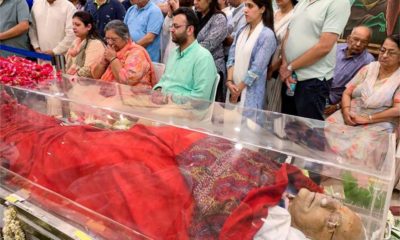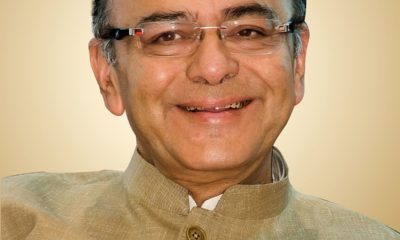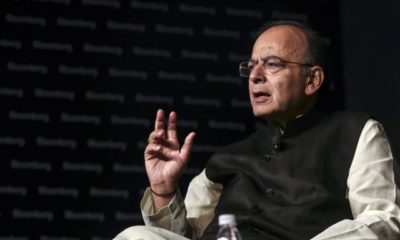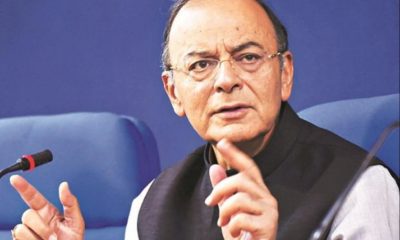Feature
India more confident in economic affairs with other nations: Jaitley
New York: India’s confidence level in dealing with other countries economically has risen and it is now in a position to boldly consider multilateral trade arrangements as it has emerged as the fastest-growing major economy amid a “grim” global situation, according to Finance Minister Arun Jaitley.
India once had “fears” about trade agreements, he said Monday at the Asia Society here in answer to a question about India’s attitude to the the Trans-Pacific Partnership (TPP). The trade pact is to bring closer together the economies of 12 nations stretching from New Zealand to Chile along the Pacific rim and include the United States. India is not in consideration for joining the pact, which has become controversial in the US because of fears of competition from further opening its markets.
Developed countries going to protectionism is what is worrisome, Jaitley added.
Highlighting India’s emerging strength in the global economy, India’s ambassador to the United States, Arun Kumar Singh, said that in economic cooperation between the two countries, investments and job creation now went both ways. Indian companies had invested over $15 billion in the US and created about 100,000 jobs.
Jaitley agreed with former Australian Prime Minister Kevin Rudd who said he had noticed that in India the language of discourse about the economy had shifted away to discussions of the regulatory environment, growth and role of manufacturing. Rudd, who is now the president of the Asia Society Policy Institute and presided over the meeting, mentioned it as a sign of the maturing of the Indian economy and society.
Commenting on Rudd’s observation, Jaitley said the sections of society that support economic reforms are now bigger than those that oppose them.
India’s “competitive federalism” was helping speed up the pace of and change in attitude to reforms, he said. On the mainland all the states had turned revenue surplus except for the leftist states of Kerala and West Bengal, Jaitley said. But now even those states were coming on board with Kerala developing a private port and West Bengal wooing global investors.
The president of the Confederation of Indian Industry (CII), Naushad Forbes, said that while land reforms were stalled at the national level, states were taking the initiative in this area. Rajasthan, ruled by the Bharatiya Janata Party, and Tamil Nadu, run by a party that is in the opposition at the center, had both enacted land reforms and this was a sign of the emerging consensus for reforms, he said.
Forbes said that about a third of the new projects launched in India in recent times were in Telengana and Andhra Pradesh and this was because of the economic competition between the states.
Answering questions after his speech on “Make in India: The New Deal,” Jaitley described the global economic situation as “grim.” It was “worrisome” when many countries began to consider a growth rate of 1 to 2 percent “good.”
Although the global economic slowdown was hurting Indian exports, India’s own economy was doing well overall, he said. But at the same time, it could do better in regard to poverty reduction and industrialisation, he conceded.
The BJP government’s “New Deal” of Make in India was born of the need to alleviate the stress caused to the Indian economy with about 50 percent of the population working in the agriculture sector and the need to shift them away from it, Jaitley said.
He outlined the various measures taken by the government to help bring in investments for its Make in India policy, such as speeded up and transparent decision-making, reducing the discretionary element and giving a role for the market forces, and changes in taxation policy, while at the same time heavily investing in the infrastructure.
The areas for private investment were being expanded to now include defence, the railways, seaports, airports and other infrastructure, he said.
Economic Affairs Secretary Shaktikanta Das said that for Make in India, the nation wanted to offer a low-cost manufacturing environment, but this did not mean low wages. The low-cost structure would be achieved through lower financial costs, lower transaction costs, lower taxes, better logistics through infrastructure improvements, and an efficient bond market, he added.
Forbes said that the CII expected India’s growth rate to reach 8 percent this year because the monsoons were good after two bad years.
Entertainment
Meghalaya Reserves Legalized Gambling and Sports Betting for Tourists

The State Scores Extra High on Gaming-Friendly Industry Index
Meghalaya scored 92.85 out of 100 possible points in a Gaming Industry Index and proved to be India’s most gaming-friendly state following its recent profound legislation changes over the field allowing land-based and online gaming, including games of chance, under a licensing regime.
The index by the UK India Business Council (UKIBC) uses a scale of 0 to 100 to measure the level of legalisation on gambling and betting achieved by a state based on the scores over a set of seven different games – lottery, horse racing, betting on sports, poker, rummy, casino and fantasy sports
Starting from February last year, Meghalaya became the third state in India’s northeast to legalise gambling and betting after Sikkim and Nagaland. After consultations with the UKIBC, the state proceeded with the adoption of the Meghalaya Regulation of Gaming Act, 2021 and the nullification of the Meghalaya Prevention of Gambling Act, 1970. Subsequently in December, the Meghalaya Regulation of Gaming Rules, 2021 were notified and came into force.
All for the Tourists
The move to legalise and license various forms of offline and online betting and gambling in Meghalaya is aimed at boosting tourism and creating jobs, and altogether raising taxation revenues for the northeastern state. At the same time, the opportunities to bet and gamble legally will be reserved only for tourists and visitors.
“We came out with a Gaming Act and subsequently framed the Regulation of Gaming Rules, 2021. The government will accordingly issue licenses to operate games of skill and chance, both online and offline,” said James P. K. Sangma, Meghalaya State Law and Taxation Minister speaking in the capital city of Shillong. “But the legalized gambling and gaming will only be for tourists and not residents of Meghalaya,” he continued.
To be allowed to play, tourists and people visiting the state for work or business purposes will have to prove their non-resident status by presenting appropriate documents, in a process similar to a bank KYC (Know Your Customer) procedure.
Meghalaya Reaches Out to a Vast Market
With 140 millions of people in India estimated to bet regularly on sports, and a total of 370 million desi bettors around prominent sporting events, as per data from one of the latest reports by Esse N Videri, Meghalaya is set to reach out and take a piece of a vast market.
Estimates on the financial value of India’s sports betting market, combined across all types of offline channels and online sports and cricket predictions and betting platforms, speak about amounts between $130 and $150 billion (roughly between ₹9.7 and ₹11.5 lakh crore).
Andhra Pradesh, Telangana and Delhi are shown to deliver the highest number of bettors and Meghalaya can count on substantial tourists flow from their betting circles. The sports betting communities of Karnataka, Maharashtra, Uttar Pradesh and Haryana are also not to be underestimated.
Among the sports, cricket is most popular, registering 68 percent of the total bet count analyzed by Esse N Videri. Football takes second position with 11 percent of the bets, followed by betting on FIFA at 7 percent and on eCricket at 5 percent. The last position in the Top 5 of popular sports for betting in India is taken by tennis with 3 percent of the bet count.
Local Citizens will Still have Their Teer Betting
Meghalaya residents will still be permitted to participate in teer betting over arrow-shooting results. Teer is a traditional method of gambling, somewhat similar to a lottery draw, and held under the rules of the Meghalaya Regulation of the Game of Arrow Shooting and the Sale of Teer Tickets Act, 2018.
Teer includes bettors wagering on the number of arrows that reach the target which is placed about 50 meters away from a team of 20 archers positioned in a semicircle.
The archers shoot volleys of arrows at the target for ten minutes, and players place their bets choosing a number between 0 and 99 trying to guess the last two digits of the number of arrows that successfully pierce the target.
If, for example, the number of hits is 256, anyone who has bet on 56 wins an amount eight times bigger than their wager.






















